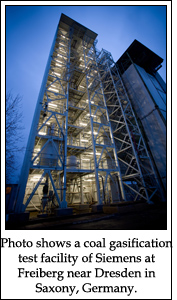
An Integrated Gasification Combined Cycle (IGCC) is a new technology for generating electricity through coal, albeit with significantly lower adverse environmental impact when compared with conventional coal-fired plants.
In an IGCC-based power plant, a gasifier is used to first convert coal into synthesis gas (or syngas) that is predominantly a mixture of hydrogen and carbon monoxide. This syngas is cleaned are removed before it is combusted. Impurities like sulphur and mercury are converted into reusable byproducts, thereby restricting the emission of dangerous gases like sulphur dioxide. IGCC technology can also be used to generate energy from other dirty fuels like petroleum residue, low-grade coal, etc.
The most important part of the IGCC plant is that before syngas is combusted, “carbon” is captured and permanently buried underground. This is known as pre-combustion carbon capture and sequestering. It may be mentioned that this “carbon” is in the form of carbon dioxide, which in turn is carbon monoxide of the syngas converted through what is called as a water/gas shift process.
The filtered syngas, which is now largely hydrogen, is used as fuel as in a typical gas-fired power plant. Excess heat that is generated during the combustion of gas is collected and used to fire a steam turbine, in combined cycle mode. This improves the efficiency of coal further. An IGCC power plant can attain efficiency of 45 per cent compared with around 25 per cent of conventional coal-fired power plants.
There are several companies like Siemens, Mitsubishi and GE – only to name a few — that have developed IGCC technology. However, the capital cost of an IGCC power plant is significantly higher than that of conventional coal-fired power plants. All the same, IGCC is considered to be today the most promising technology for generating energy with the lowest carbon footprint. The efficiency of an IGCC plant also depends on the design. Engineers are striving to improve efficiencies of IGCC technologies and at the same time keeping a check on capital costs.
World over, commercial IGCC plants began appearing from the mid-1990s. Countries like USA, Japan, Italy, Germany and Spain have such plants with capacities ranging from 100 mw to even 500 mw.
India has taken initial steps in setting up demonstration IGCC plants. In around 2008, BHEL tied up with Andhra Pradesh Power Generation Company (APGenco) to set up a 100-mw IGCC plant. The project did not make any progress due to pre-project difficulties including inability to secure government grants, etc. Very recently, BHEL tied up with NTPC to set up a 100-mw demonstration IGCC plant.